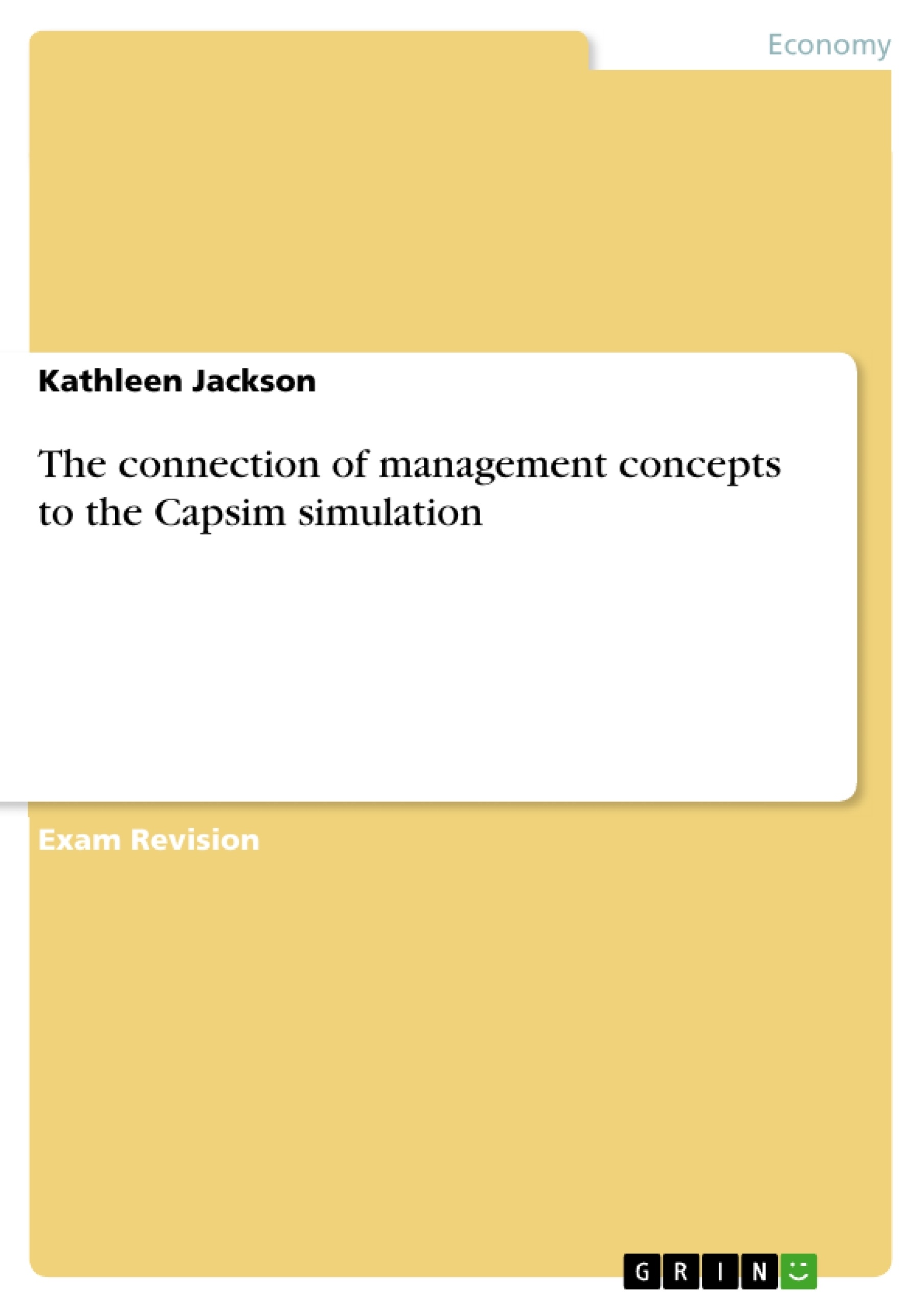Covered in the text are various concepts of management, including strategy, functions of management and business decisions. Each of those is discussed in connection to the Capsim simulation.
Table of Contents
- Instructions
- Selected Responses
- Strategy
- Functions of Management
- Goals and Objectives
- Benchmarking
- Decisions
- Reflection
- References
Objectives and Key Themes
The objective of this simulation reflection is to analyze the application of various business management concepts within a simulated business environment. The author reflects on their team's performance, strategies employed, and lessons learned throughout the simulation.
- Strategic Management and its impact on corporate leadership
- Application of primary management functions (planning, organizing, leading, controlling)
- Goal setting and objective achievement
- Contingency planning and decision-making
- Benchmarking and performance analysis
Chapter Summaries
Selected Responses: This section serves as an introduction to the simulation reflection, outlining the specific questions addressed in the subsequent chapters. It sets the stage for a detailed analysis of the team's experience and performance within the simulated business environment.
Strategy: This chapter defines strategy and explores its significant role in corporate management and leadership. It uses the Capsim simulation as a real-world example, illustrating how strategic choices impact various aspects of business operations, from resource allocation and product development to pricing and communication strategies. The author discusses how varying strategies require adjustments in management style, employee responsibilities, and communication approaches to successfully meet long-term goals and stakeholder expectations.
Functions of Management: This chapter examines the application of the primary functions of management—planning, organizing, leading, and controlling—within the context of the simulation. The author provides specific examples of how each function was implemented in the simulated business environment, analyzing their effectiveness and impact on overall performance. This section likely demonstrates an understanding of classical management theories and their practical application.
Goals and Objectives: This chapter defines and differentiates between goals and objectives, explaining how both were integrated into the simulation. It likely explores the process of setting both short-term and long-term goals, outlining how they were used to guide decision-making and measure success. The author will likely explain the importance of aligning objectives with overall strategy to achieve desired outcomes.
Benchmarking: This chapter defines benchmarking and discusses its application within the simulation. It likely explains the process of identifying best practices and comparing the team's performance against those benchmarks. The author probably analyzes the insights gained from this comparison, highlighting areas of strength and weakness and suggesting potential improvements for future performance.
Decisions: This chapter analyzes the various strategic, tactical, and operational decisions made during the simulation. It likely provides examples of each type of decision, explaining the rationale behind them and evaluating their impact on the team's overall success. The analysis likely emphasizes the decision-making process, considering factors such as available information, risk assessment, and contingency planning.
Keywords
Strategy, corporate management, leadership, management functions, goals, objectives, benchmarking, contingency planning, decision-making, simulation, performance analysis, process improvement.
Frequently Asked Questions: Comprehensive Language Preview
What is the purpose of this document?
This document provides a comprehensive overview of a simulation reflection focusing on the application of various business management concepts within a simulated business environment. It includes a table of contents, objectives and key themes, chapter summaries, and keywords.
What topics are covered in this simulation reflection?
The reflection analyzes the team's performance in a business simulation, covering strategic management, the four primary management functions (planning, organizing, leading, controlling), goal setting, objective achievement, contingency planning, decision-making, benchmarking, and performance analysis.
What are the key themes explored in the document?
Key themes include the impact of strategic management on corporate leadership, the practical application of management functions, the importance of goal setting and objective achievement, the role of contingency planning and decision-making, and the use of benchmarking for performance analysis and improvement.
What is the structure of the document?
The document is structured into several chapters: Instructions, Selected Responses, Strategy, Functions of Management, Goals and Objectives, Benchmarking, Decisions, and Reflection. Each chapter provides a summary of its contents and contribution to the overall reflection.
What is discussed in the "Strategy" chapter?
This chapter explores the significant role of strategy in corporate management and leadership, using the Capsim simulation as a real-world example. It illustrates how strategic choices impact various aspects of business operations and how varying strategies require adjustments in management style and communication.
What is covered in the "Functions of Management" chapter?
This chapter examines the application of the four primary functions of management (planning, organizing, leading, and controlling) within the simulation. It provides specific examples of how each function was implemented and analyzes their effectiveness and impact on overall performance.
What does the "Goals and Objectives" chapter address?
This chapter defines and differentiates goals and objectives, explaining how both were integrated into the simulation. It explores the process of setting short-term and long-term goals, how they guided decision-making, and the importance of aligning objectives with overall strategy.
How is benchmarking discussed in this document?
The "Benchmarking" chapter defines benchmarking and discusses its application within the simulation. It explains the process of identifying best practices, comparing the team's performance against benchmarks, and analyzing the insights gained to suggest potential improvements.
What kind of decisions are analyzed in the reflection?
The "Decisions" chapter analyzes strategic, tactical, and operational decisions made during the simulation, explaining the rationale behind them and evaluating their impact on the team's success. It emphasizes the decision-making process, including factors like information, risk assessment, and contingency planning.
What are the key words associated with this document?
Key words include: Strategy, corporate management, leadership, management functions, goals, objectives, benchmarking, contingency planning, decision-making, simulation, performance analysis, and process improvement.
- Citar trabajo
- Kathleen Jackson (Autor), 2018, The connection of management concepts to the Capsim simulation, Múnich, GRIN Verlag, https://www.grin.com/document/417971



